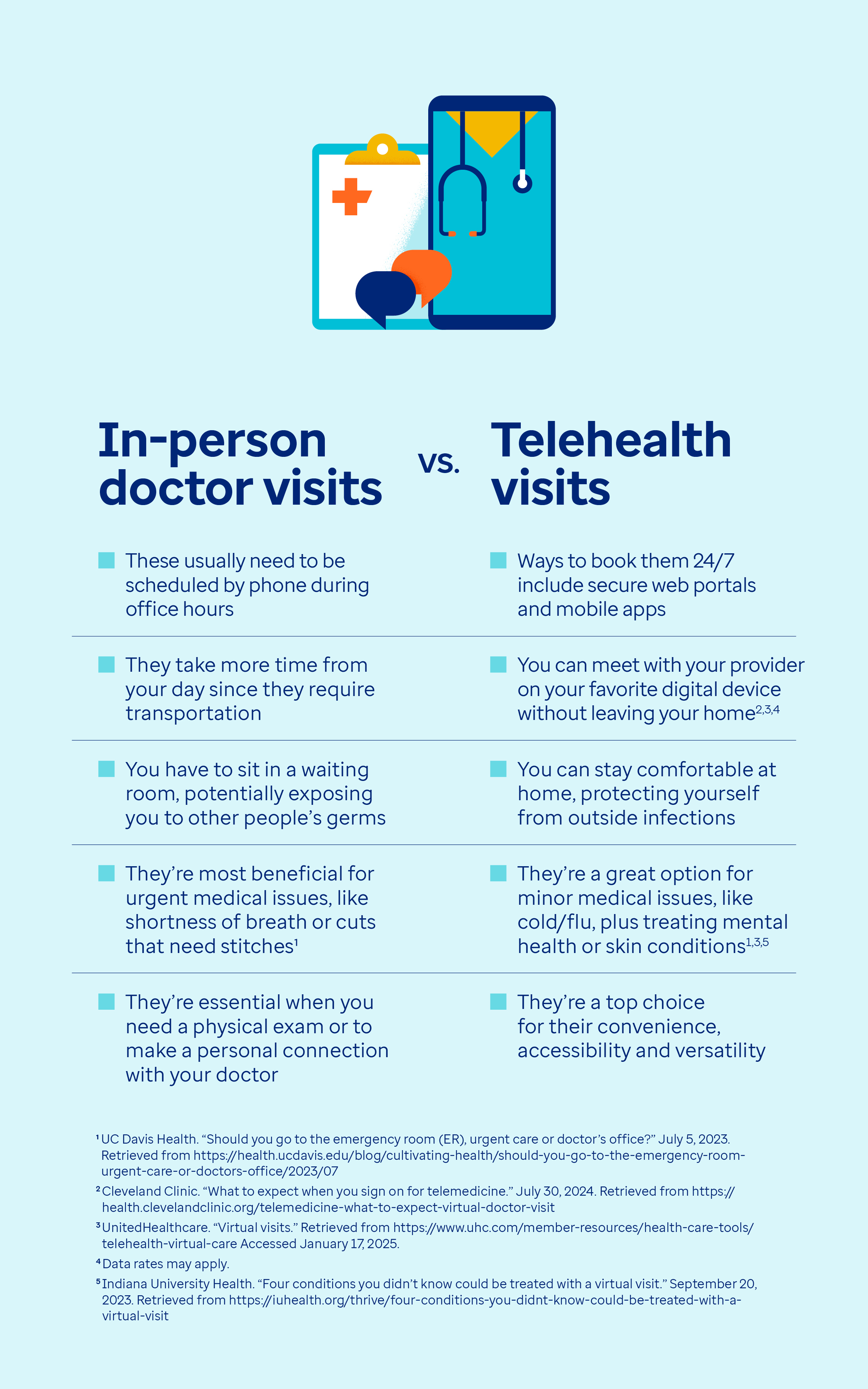Did you know that there are more than 258,000 nurse practitioners (NPs) employed in the United States, as well as 140,000 physician assistants (PAs)? Both NPs and PAs offer medical care that is combined with a focus on your individual health needs. And they can be a practical alternative to doctors. They may also help cut back on those long wait times.
Here’s a look at what NPs and PAs are, how they’re different and what kind of care you can expect from them.
Want to skip the waiting room? Our telehealth membership provides care for general medicine, behavioral health and dermatology. You can also call 1-844-211-7730 for more information.
What is a nurse practitioner, and can I choose one as my primary care provider?
A nurse practitioner, or NP, is a highly educated and trained health care provider who can fill many roles in health care, including being your primary care provider.
For someone to become an NP, they must:
- Be a licensed registered nurse (RN) with a Bachelor of Science in Nursing degree
- Complete a master’s or doctoral degree program
- Receive advanced clinical training
They have to do hundreds of hours of coursework and practical training, which builds the advanced knowledge, skills and abilities needed to practice in primary care, acute care and long-term health settings. In addition to primary care, NPs work in community health clinics, hospitals, emergency rooms, psychiatric facilities and operating rooms. They take care of patients of all ages — from infants to older adults.
They play a very important and much needed role in health care, says Leanne Fowler, a Doctor of Nursing practice in New Orleans. “I think the greatest impact of their role is to improve and increase access to primary care, specialty care and hospital care,” says Fowler.
Besides taking part in primary care, NPs can:
- Diagnose and treat illnesses
- Do physical exams and routine screenings
- Give vaccines
- Prescribe medications
- Read lab results
- Take care of a range of medical procedures, from treating diabetes to setting broken bones
What a nurse practitioner does and who they can do it for — also known as their scope of practice — depends on their licensure and training, as well as the laws of the state they work in. In some states, they can have their own private practice. In other states, they are required to be supervised by a medical doctor or contract with a physician to be able to offer their services.
Enter your zip code to find the virtual care plan options available in your area or contact a licensed insurance agent at 1-844-211-7730 for more information.
What is a physician assistant, and can I choose one as my primary care provider?
Like NPs, physician assistants, or PAs, have to get a certain level of experience and education before they can work in hospitals and clinical practices. While they practice medicine under the direction and supervision of a licensed physician, they can also serve as primary care physicians.
Education-wise, PAs usually take this route:
- Bachelor’s degree in health care or the sciences
- Complete a master’s program
- Take a 300-question, 5-hour exam to receive PA credentials
- Receive a license from their state medical board (this varies state by state)
Here’s a look at some of the things PAs can do:
- Develop patient treatment plans
- Order labs and diagnostic studies
- Perform physical exams
- Prescribe medications
- Take patient histories
Besides primary care, PAs also tend to practice in a number of health care disciplines, including:
- Emergency medicine
- Family medicine
- Internal medicine
- Pediatrics
- Surgery
Their jobs can also include clinical practice, patient education, team leadership, medical education, health administration and research.

What’s the difference between a nurse practitioner and a physician assistant?
While both an NP or a PA can serve as your primary care physician, there are some differences in what they do. The main differences include:
- NPs tend to specialize in focusing on patients who may be of a certain age or have a particular condition, while PAs tend to focus on a specific area of medicine (i.e., emergency or internal).
- Both NPs and PAs work independently, but in most states, PAs have to work with or under a physician.
- NPs mainly adhere to a patient-focused nursing model of care, while PAs follow a disease-centered model.
Why should you see a nurse practitioner over a physician assistant (or vice versa)?
That’s really up to you. Since they can both do a lot of the same things that a doctor can do, such as perform physical exams and prescribe medications, they’ll both give you the care you need to stay healthy. And that’s what seeing a health care provider is all about.
Learn more about scheduling telehealth appointments with the provider of your choice today. You can also call 1-844-211-7730 for more information.
The article above is provided as general information only. It is not intended to diagnose or recommend treatment of any illness, disease or condition. You should consult a qualified medical professional if you have questions or need more information.
Sources
American Association of Nurse Practitioners. “What’s a Nurse Practitioner (NP)?” Retrieved from https://www.aanp.org/about/all-about-nps/whats-a-nurse-practitioner Accessed June 14, 2023.
Marymount University. “Full Practice Authority States for Family Nurse Practitioners 2023.” Updated February 1, 2023. Retrieved from https://online.marymount.edu/blog/full-practice-authority-for-nurse-practitioners
Regis College. “What’s the Difference Between a Nurse Practitioner and Physician Assistant?” June 7, 2021. Retrieved from https://www.regiscollege.edu/blog/nursing/nurse-practitioner-vs-physician-assistant
Tufts University School of Medicine. “What Is a Physician Assistant?” Retrieved from https://medicine.tufts.edu/academics/physician-assistant/pa-program-overview/what-physician-assistant Accessed June 8, 2023.
University of Pittsburgh Online School of Health and Rehabilitation Sciences. “What Degree(s) Do You Need to Become a PA?” January 21, 2022. Retrieved from https://online.shrs.pitt.edu/blog/what-degrees-do-you-need-to-become-a-physician-assistant/
University of St. Augustine for Health Sciences. “Nurse Practitioner vs. Physician Assistant: Key Differences.” September 11, 2022. Retrieved from https://www.usa.edu/blog/np-vs-pa/
U.S. Bureau of Labor Statistics. “Occupational Employment and Wage Statistics: Nurse Practitioners.” April 25, 2023. Retrieved from https://www.bls.gov/oes/current/oes291171.htm
U.S. Bureau of Labor Statistics. “Occupational Employment and Wage Statistics: Physician Assistants.” April 25, 2023. Retrieved from https://www.bls.gov/oes/current/oes291071.htm#nat
Compliance code:
49889-X-0923











